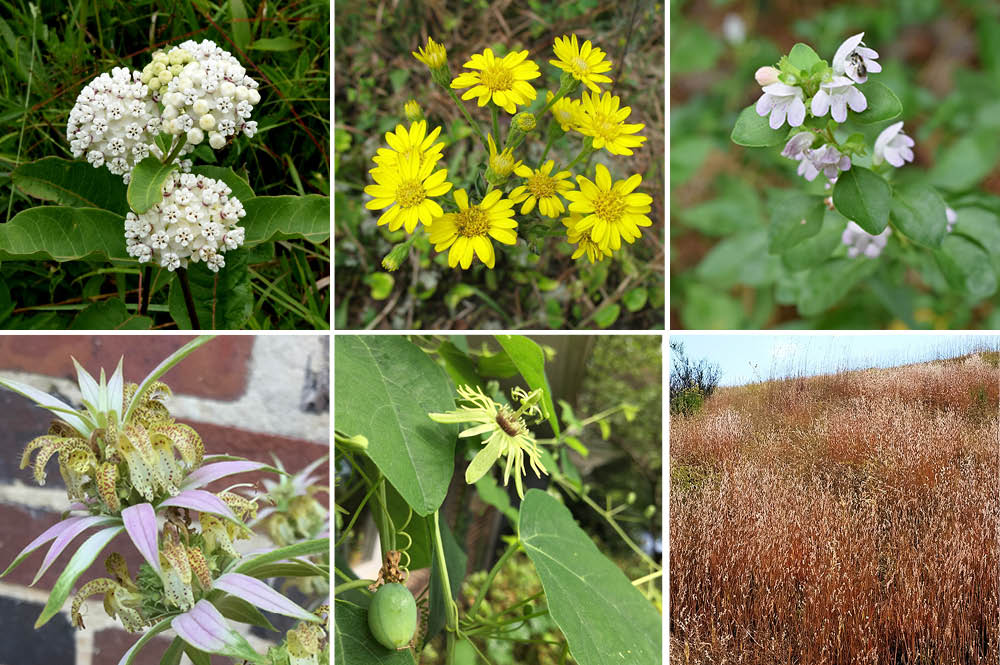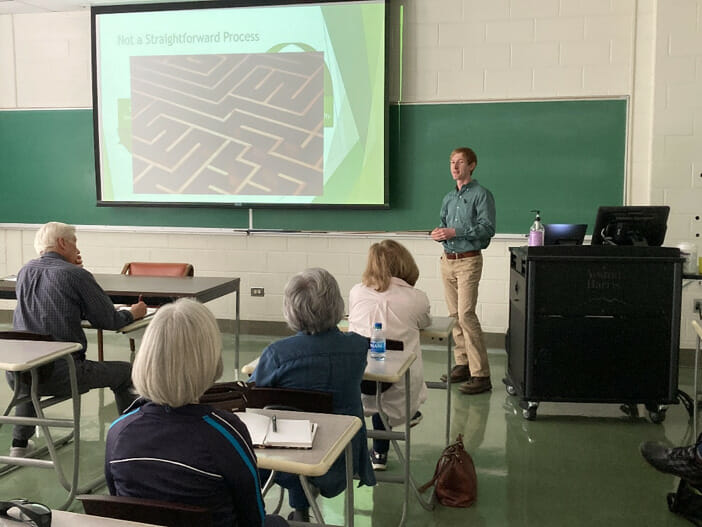
Plant of the Year nominees for 2023, clockwise from top left: Asclepias variegata (white milkweed, redring milkweed), Chrysopsis mariana (Maryland golden-aster), Clinopodium georgianum (Georgia basil, Georgia calamint or Georgia savory), Schizachyrium scoparium (little bluestem), Passiflora lutea, (yellow passionflower), and Monarda punctata (spotted beebalm).
In This Issue ...
- Plant of the Year voting starts now!
- Spotlight on roadside asters
- Chapter News
Plant of the Year Voting is Open
Valerie Boss
We are pleased to announce the nominees for the 2023 GNPS Plant of the Year (pictured above):
- Asclepias variegata (white milkweed or redring milkweed),
- Chrysopsis mariana (Maryland golden-aster),
- Clinopodium georgianum (Georgia basil, Georgia calamint or Georgia savory),
- Monarda punctata (spotted beebalm)
- Passiflora lutea (yellow passionflower), and
- Schizachyrium scoparium (little bluestem).
Thanks to everyone who participated by nominating their favorite. Voting is now open and will continue through November 30th. You can learn more about the nominees here on the website, and you can go to the voting page here and help your favorite plant rise to the top.
Plant Spotlight: Roadside White Asters
Ellen Honeycutt

Left: Symphyotrichum pilosum. Right: Symphyotrichum racemosum.
Overlooked for most the year, this is the time for the many species of small white asters to shine. These perennial species produce heavily-laden stems of tiny flowers, which are visited by small bees and migrating butterflies. We have a number of species of small white asters in Georgia, but four of them are more common than others and two even more so. If you want to identify them, get familiar with the word phyllary, which is the green bract underneath the flowerhead; it’s a key concept (literally) in aster identification.
When it comes to the roadside white asters, the two species most abundant are known as the “oldfield” white asters. One has noticeably fine hairs on the stem and is called the hairy oldfield white aster or frost aster (Symphyotrichum pilosum) while the other has less noticeable hairs and is called the smooth oldfield aster or tiny white aster (Symphyotrichum racemosum).
Symphyotrichum racemosum is the most abundant aster in my garden, taking over one bed almost entirely. The spindly limbs allow the sun to reach the spring and summer perennials, so it plays fairly well with other plants. Come October, those spindly limbs are transformed into arching stems of small white flowers. Not enough resources talk about how the flowers are largely arranged on one side of the stem; that is something I always look for when identifying this species. Phyllaries are appressed (flat).
Symphyotrichum pilosum is distinctive among the common species if you can get a look at the phyllaries. These small green structures are not appressed in this species, they are reflexed away from the flowerhead. There are noticeable fine hairs along the stems, sometimes giving it a frosted appearance. This species can vary in size depending on the growing conditions available, reaching up to 4 feet tall and wide when favorable.

Left: Symphyotrichum lateriflorum. Right: Symphyotrichum dumosum
Symphyotrichum dumosum is often called long-stalk aster, a name that points to a trait that can be useful in identifying it. With its appressed phyllaries, it most resembles S. racemosum, but the flowers are larger in size and generally there are fewer of them. Long, thin leaves are also useful when identifying it as they can still be present at flowering time.
Symphyotrichum lateriflorum is named for having flowers along one side (lateriflorum) but, as you may recall, there is another species that has similar arrangement (S. racemosum). It differs from S. racemosum by having wider, toothed stem leaves (I think they are darker green too). In addition, the flowers are generally smaller, and the disk centers are not bright yellow (more tan-colored) and they age to purple compared to a reddish color on S. racemosum. S. lateriflorum has the very charming common name of calico aster.
You don’t have to figure out which species is which in order to grow, enjoy, and appreciate these tiny fall beauties. But if you want to, I’ll borrow some text from Linda Chafin’s Field Guide to the Wildflowers of Georgia, who likens them to the botanists’ version of confusing fall warblers:
“No single trait distinguishes any particular species but taking several traits into consideration can usually lead to a sure identification.” See page 120-121 of this very excellent book for more.
(Adapted from my 2020 blog entry)
Chapter News

Plants recently rescued by Augusta's River Region Chapter members.
Augusta's River Region Chapter
Augusta's River Region Chapter has a meeting about removing invasive species on November 5th at Reed Creek Park in Martinez, Georgia. Reed Creek will be one of our restoration sites, so identifying the invasives that will need to be removed is crucial. Anyone interested in this project should attend. The chapter hosted its first in-person plant sale on October 15th at Reed Creek Park. There were hundreds of rescued plants, plants consigned from our partnership with Asclepias and More, and plants donated by chapter members. We were nearly sold out by 1:00 in the afternoon! Attendees expressed excitement about being able to purchase native plants and to learn about them. Plans are in the works for a spring sale.
Coastal Plain Chapter
Saturday, Nov. 5th will be the chapter’s last plant sale of the season at the Wiregrass Farmers Market in Tifton, from 9 a.m. to noon. Online purchases are always available before and after these sales, with a minimum order of $25. Check the plant inventory list, updated after each sale.
Saturday, Nov. 12th is the Coastal Plain Chapter’s annual fall meeting, at the Okefenokee Swamp Park in Waycross. Following a short business meeting, two educational sessions are planned. Retired Callaway Gardens Horticulturist Kathy Crye will present Transitioning Your Back Yard to a Pollinator Habitat. CPC member Beth Grant, founder of Wolf Creek Trout Lily Preserve and Lost Creek Forest in Thomas County, is presenting Doug Tallamy’s Bringing Nature Home, with permission by Dr. Tallamy.
Following lunch and a seed swap, Katie Antczak, Environmental Education Coordinator at the Okefenokee Swamp Park, will guide us along nature trails at the park.
Registration cost is $20, which includes lunch, snacks, and admission to the park. Please complete registration by Nov 5th to be assured of your lunch order.
Fringed Campion Chapter
The Fringed Campion Chapter of Middle GA has the following events coming up:
- 10:00 a.m. on Nov. 5th at Mercer University: Annual Meeting with a presentation on Regenerative Horticulture.
- 12:00 noon on Nov. 14th: Virtual Lunch and Learn, co-hosted with Georgia Women, Bee City Initiatives of the Xerces Society.
- 10:00 a.m. on Nov. 19th: Invasives Removal Workday at Rose Hill Cemetery, Macon.
- 10:00 a.m. on Dec. 3rd, 10:00 a.m.: Native Plant Hike at Piedmont National Wildlife Refuge.
To find out more and register see our Facebook page.
North Georgia Mountains Chapter
The presenter at our October meeting was Zach Wood, who spoke on the topic of Restoring Georgia’s Native Grasslands. It might not be obvious that grasslands were once a significant part of the ecosystem in the mountains — they definitely were significant, and they need to be restored. But the process isn’t simple, as the title of the slide in his presentation as seen in the photo indicates. But there are things we can all do to help. The speaker at our November meeting will be Felicity Davis with GDOT, talking about things that we are more likely to notice on a regular basis.

Zach Wood addressing the North Georgia Mountains chapter about Restoring Georgia’s native grasslands at the October meeting.
Intown Atlanta Chapter
The chapter is holding a Nature Needs You! presentation on November 12th, from 11:00 a.m. to 1:00 p.m. on the Emory University campus.
Presenter Vicki Mann will share ten simple but effective ideas to improve your yard's habitat. She will focus on how to get started and resources to help. The presentation, “Your Yard Is Nature’s Best Hope”, is based on Leslie Nelson Inman’s book, “Your Yard is Nature” and the teachings of Doug Tallamy.
Mann is Co-Founder of QuietGA, an organization that is working to reduce the use of gas-powered leaf blowers in favor of quieter, healthier and greener alternatives. Attendees can participate in a raffle for a free, high habitat value, perennial native plant that is important to the Intown Atlanta eco-system and will get a Liatris (blazing star) seed packet to use for winter sowing.
Leslie Inman will share the stage with Vicki for the Q&A portion of the event. An avid native plant gardener, she started gardening after hearing Dr. Tallamy speak about the importance of native plants. She has written and illustrated two children’s books about pollinators and their native host plants and has a Facebook group – Pollinator Friendly Yards, with 166,000 members.
Register at Eventbrite: Here. Parking is free.
White Hall, Room 205
301 Dowman Dr, Atlanta, GA 30322
|